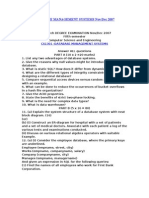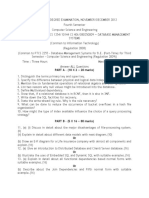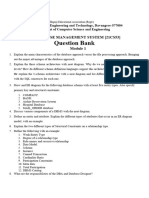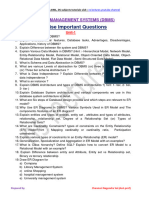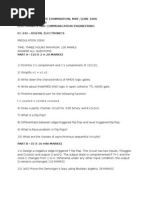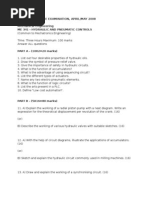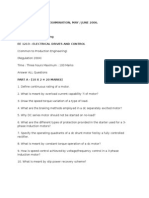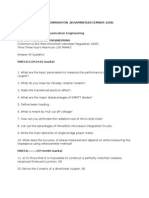0 ratings0% found this document useful (0 votes)
105 viewsM.C.A. Degree Examination
M.C.A. Degree Examination
Uploaded by
subhazThis document appears to be exam questions for a Database Management Systems exam covering topics like:
- The importance of database management systems for data handling
- Semantic data models and integrity constraints in relational models
- The use of embedded SQL, hash-based indexing, and composite search keys
- Query optimization, evaluation plans, and locking protocols for concurrency control
- Recovery management functions
It includes both short answer and long answer questions testing understanding of concepts like entity-relationship diagrams, key constraints, cursors, foreign keys, relational design from ER models, hash indexing, RAID redundancy, query optimization techniques, and transaction management using COMMIT, ROLLBACK, and SAVEPOINT statements.
Copyright:
Attribution Non-Commercial (BY-NC)
Available Formats
Download as DOCX, PDF, TXT or read online from Scribd
M.C.A. Degree Examination
M.C.A. Degree Examination
Uploaded by
subhaz0 ratings0% found this document useful (0 votes)
105 views1 pageThis document appears to be exam questions for a Database Management Systems exam covering topics like:
- The importance of database management systems for data handling
- Semantic data models and integrity constraints in relational models
- The use of embedded SQL, hash-based indexing, and composite search keys
- Query optimization, evaluation plans, and locking protocols for concurrency control
- Recovery management functions
It includes both short answer and long answer questions testing understanding of concepts like entity-relationship diagrams, key constraints, cursors, foreign keys, relational design from ER models, hash indexing, RAID redundancy, query optimization techniques, and transaction management using COMMIT, ROLLBACK, and SAVEPOINT statements.
Original Title
m.c.a. Degree Examination
Copyright
© Attribution Non-Commercial (BY-NC)
Available Formats
DOCX, PDF, TXT or read online from Scribd
Share this document
Did you find this document useful?
Is this content inappropriate?
This document appears to be exam questions for a Database Management Systems exam covering topics like:
- The importance of database management systems for data handling
- Semantic data models and integrity constraints in relational models
- The use of embedded SQL, hash-based indexing, and composite search keys
- Query optimization, evaluation plans, and locking protocols for concurrency control
- Recovery management functions
It includes both short answer and long answer questions testing understanding of concepts like entity-relationship diagrams, key constraints, cursors, foreign keys, relational design from ER models, hash indexing, RAID redundancy, query optimization techniques, and transaction management using COMMIT, ROLLBACK, and SAVEPOINT statements.
Copyright:
Attribution Non-Commercial (BY-NC)
Available Formats
Download as DOCX, PDF, TXT or read online from Scribd
Download as docx, pdf, or txt
0 ratings0% found this document useful (0 votes)
105 views1 pageM.C.A. Degree Examination
M.C.A. Degree Examination
Uploaded by
subhazThis document appears to be exam questions for a Database Management Systems exam covering topics like:
- The importance of database management systems for data handling
- Semantic data models and integrity constraints in relational models
- The use of embedded SQL, hash-based indexing, and composite search keys
- Query optimization, evaluation plans, and locking protocols for concurrency control
- Recovery management functions
It includes both short answer and long answer questions testing understanding of concepts like entity-relationship diagrams, key constraints, cursors, foreign keys, relational design from ER models, hash indexing, RAID redundancy, query optimization techniques, and transaction management using COMMIT, ROLLBACK, and SAVEPOINT statements.
Copyright:
Attribution Non-Commercial (BY-NC)
Available Formats
Download as DOCX, PDF, TXT or read online from Scribd
Download as docx, pdf, or txt
You are on page 1of 1
M.C.A.
DEGREE EXAMINATION
NOV/DEC 2006
SECOND SEMESTER
DATABASE MANAGEMENT SYSTEM
(REGULATION 2005)
ANSWER ALL QUESTIONS
PART- A (10x2= 20 marks)
1. How Is the database management system indispensable I data handling?
2. What is semantic data model?
3. What are integrity constraints in relational model?
4. What is the use of embedded Sql?
5. Define hash based indexing in data storage operations.
6. what are composite search keys? explain with a example.
7. what do you meant by query optimization?
8. what does a query eevaluation plan consists of?
9. state the purpose of locking protocol indbms operations.
10. what are the two important functions of recvery management?
PART B (5x16=80 marks)
11.a.i. Narrate the advantage of dbms systems.
or
11.a.ii. Discuss the steps involved in the design of database systems.
11.b.i. Illustrate the concept of relationships and relationship sets in entity
relationship (ER) diagrams, witha suitable examples.
11.b.ii. Elaborate o the key constraint construct in ER models, with an example.
12.a.i. What is the use of cursors in embedded SQL? Specif the basic cursor
definition format, giving illustrative examples?
12.a.ii. Give an example of foreign key constraintsin relational models and develo a
SQL statement for the same.
12.b. How are the relational models designed based on the ER models? Discuss with
respect to the issues of tables, relationship without constraints and key constraints?
13.(a) explain the mechanism of hash based indexing with an example.
13.(b) Describe the various levels of redundancy in RAID systems in detail.
14.(a) Explain the working of query optimizer with ablock diagram.
14.(b) Discuss the issues in implementing optimization strateges for the JOIN s
queries.
15.(a) What is the role of COMMIT, ROLLBACK and SAVEPOINT the SQL statements in
transaction management?
15.(b) Write short notes on buffer management.
You might also like
- QpaperDocument13 pagesQpaperGangaa ShelviNo ratings yet
- MC0077Document2 pagesMC0077AnilkumarsanctumNo ratings yet
- DBMS Question PaperDocument11 pagesDBMS Question PaperAnchugam KeerthiNo ratings yet
- End Semester Examination, 2014-15Document3 pagesEnd Semester Examination, 2014-15kfrahmanNo ratings yet
- Database Management Systems NovDocument6 pagesDatabase Management Systems NovRajaMaariyapanNo ratings yet
- CS2029 QBDocument14 pagesCS2029 QBkanimozhitmNo ratings yet
- Question BankDocument3 pagesQuestion BankShobana Balaraman RajendranNo ratings yet
- Ques Bank DBMSDocument8 pagesQues Bank DBMSAjinkya BhurukNo ratings yet
- MCS-023 Importamt QuestionDocument4 pagesMCS-023 Importamt Questionestherrani684No ratings yet
- End Semester Examination, 2014-15Document3 pagesEnd Semester Examination, 2014-15kfrahmanNo ratings yet
- Data Management-. Distinguish Between Specialization and Generalization - How Will You Represent Them in An ER DiagramDocument3 pagesData Management-. Distinguish Between Specialization and Generalization - How Will You Represent Them in An ER DiagramDivya pradeepNo ratings yet
- DBMS Important QueDocument3 pagesDBMS Important QueTejinder SinghNo ratings yet
- DBMSDocument7 pagesDBMSVikram RaoNo ratings yet
- DBMS Important QuestionsDocument1 pageDBMS Important QuestionsNagaraju GuntruNo ratings yet
- MCS 043Document34 pagesMCS 043Pooja KumariNo ratings yet
- DBMSDocument8 pagesDBMSVikram RaoNo ratings yet
- DBMSDocument18 pagesDBMSJavvaji VenkatNo ratings yet
- CS2255 Au Question PaperDocument7 pagesCS2255 Au Question PaperRajeshkannan VasinathanNo ratings yet
- Manage Dbms Cat Term 1 2024Document2 pagesManage Dbms Cat Term 1 2024abrahamNo ratings yet
- MCS-014 MCA (Revised) Term-End Examination June, 2011 Mcs-014: System Analysis and DesignDocument3 pagesMCS-014 MCA (Revised) Term-End Examination June, 2011 Mcs-014: System Analysis and DesignNaruttam BorahNo ratings yet
- DataDocument2 pagesDatamadhes14No ratings yet
- Dbms Question Bank Unit IDocument2 pagesDbms Question Bank Unit Iainoc100% (1)
- DBMS PreviousDocument10 pagesDBMS PreviousSahil Kumar 1803289No ratings yet
- Kings: Department of Computer Science & Engineering Question BankDocument5 pagesKings: Department of Computer Science & Engineering Question BankbalarecNo ratings yet
- Dbms Question BankDocument4 pagesDbms Question BankVishal Chakka100% (1)
- Kings: Department of Computer Science & Engineering Question BankDocument5 pagesKings: Department of Computer Science & Engineering Question BankDhiravidanNo ratings yet
- DBMSDocument2 pagesDBMSdhakategaurav14No ratings yet
- Dmmgym-Ie: HourslDocument2 pagesDmmgym-Ie: Hourslsagar batraNo ratings yet
- DatabasesDocument10 pagesDatabasesMeregulwa AllanNo ratings yet
- Dbms Question BankDocument4 pagesDbms Question Bankoldsage2004No ratings yet
- ESIA StudyDocument28 pagesESIA StudySimbhu Ashok CNo ratings yet
- Unit I Introduction and Conceptual Modelling PART-A (2 Marks)Document6 pagesUnit I Introduction and Conceptual Modelling PART-A (2 Marks)prabha_dhandayudamNo ratings yet
- DBMS Univ Question With AnswerDocument20 pagesDBMS Univ Question With AnsweractvenkatesanNo ratings yet
- AKNU BCA Database Management SystemsDocument2 pagesAKNU BCA Database Management SystemschanduNo ratings yet
- BSC ItimDocument2 pagesBSC ItimUmesh PalakshaiahNo ratings yet
- Database Management SystemDocument5 pagesDatabase Management SystemGuruKPONo ratings yet
- MCS 014 PDFDocument42 pagesMCS 014 PDFGurjeet KaurNo ratings yet
- Modulewise Question Bank: Entity-Relationship ModelDocument5 pagesModulewise Question Bank: Entity-Relationship ModelAnkur MuzumdarNo ratings yet
- Sample Questions - DBMSDocument5 pagesSample Questions - DBMSdasg02675No ratings yet
- QUESTION BANK - DbmsDocument8 pagesQUESTION BANK - Dbmssumeetkhatri2501No ratings yet
- 4 Cse IT CS2255Document2 pages4 Cse IT CS2255BIBIN CHIDAMBARANATHANNo ratings yet
- Dbms PDFDocument4 pagesDbms PDFjancy esther100% (1)
- 21CS53 DBMS-QBDocument3 pages21CS53 DBMS-QBG09Deviprasad N shettyNo ratings yet
- DBMS CatDocument1 pageDBMS Catzordboomer01No ratings yet
- Enterprises Resource Planning and Database Management System Mbit03Document1 pageEnterprises Resource Planning and Database Management System Mbit03Ajay TripathiNo ratings yet
- Anna University Exams Nov / Dec 2019 - Regulation 2017: CS8492-Database Management Systems 1. 2. 3. 4. 5. 6Document1 pageAnna University Exams Nov / Dec 2019 - Regulation 2017: CS8492-Database Management Systems 1. 2. 3. 4. 5. 6siraskNo ratings yet
- DBMS TieDocument4 pagesDBMS TieMvpNo ratings yet
- DBMSQBM3 and M4Document2 pagesDBMSQBM3 and M4Aayeth RamziNo ratings yet
- DBMS Unitwise Imp QuestionsDocument4 pagesDBMS Unitwise Imp QuestionsShanmukha RaoNo ratings yet
- CS3492 Database Management Systems Two Mark Questions 1Document38 pagesCS3492 Database Management Systems Two Mark Questions 1lekha100% (1)
- DBMS-Super Important questions-18CS53Document4 pagesDBMS-Super Important questions-18CS53Death WarriorNo ratings yet
- cs53 Super-Imp-Tie-23Document2 pagescs53 Super-Imp-Tie-23SAID k sNo ratings yet
- DBMS Question BankDocument69 pagesDBMS Question Bankstanygregor87No ratings yet
- MCS-014 - Optimize-1 - CompressedDocument3 pagesMCS-014 - Optimize-1 - CompressedLukundo SichalweNo ratings yet
- MIS Important-QuestionsDocument3 pagesMIS Important-QuestionsAmy AungNo ratings yet
- Question Bank RDBMS - 619404Document3 pagesQuestion Bank RDBMS - 619404avni patelNo ratings yet
- MCS 41, MCS 42, MCS 43, MCS 44, MCS 45Document13 pagesMCS 41, MCS 42, MCS 43, MCS 44, MCS 45Anup Kumar Verma0% (1)
- ND ERM Xamination: Hird Emester EcemberDocument6 pagesND ERM Xamination: Hird Emester Ecemberalwil1012No ratings yet
- Modeling and Simulation Support for System of Systems Engineering ApplicationsFrom EverandModeling and Simulation Support for System of Systems Engineering ApplicationsLarry B. RaineyNo ratings yet
- Database Design with SQL: Building Fast and Reliable SystemsFrom EverandDatabase Design with SQL: Building Fast and Reliable SystemsNo ratings yet
- Me 1304 - Engineering Metrology and MeasurementsDocument2 pagesMe 1304 - Engineering Metrology and MeasurementssubhazNo ratings yet
- Me 1304 - Engineering Metrology and MeasurementsDocument2 pagesMe 1304 - Engineering Metrology and MeasurementssubhazNo ratings yet
- Ge 035 - Professional EthicsDocument2 pagesGe 035 - Professional EthicssubhazNo ratings yet
- PH 136 - Semiconductor Physics and Opto ElectronicsDocument3 pagesPH 136 - Semiconductor Physics and Opto ElectronicssubhazNo ratings yet
- Mg-1401 Total Quality Management Question PaperDocument2 pagesMg-1401 Total Quality Management Question Papersubhaz100% (6)
- Me 433 - MechatronicsDocument2 pagesMe 433 - MechatronicssubhazNo ratings yet
- Ee 1403 - Design of Electrical ApparatusDocument3 pagesEe 1403 - Design of Electrical ApparatussubhazNo ratings yet
- MG 431-Engineering Economics and Financial AccountingDocument2 pagesMG 431-Engineering Economics and Financial AccountingsubhazNo ratings yet
- Ec 1401 Vlsi DesignDocument2 pagesEc 1401 Vlsi DesignsubhazNo ratings yet
- Mc-1654 - Database Management SystemsDocument1 pageMc-1654 - Database Management SystemssubhazNo ratings yet
- Ee 151 - Electrical EngineeringDocument3 pagesEe 151 - Electrical EngineeringsubhazNo ratings yet
- Hs 1101 - EnglishDocument7 pagesHs 1101 - EnglishsubhazNo ratings yet
- Ec 242 - Digital ElectronicsDocument2 pagesEc 242 - Digital ElectronicssubhazNo ratings yet
- Me 341 - Hydraulic and Pneumatic ControlsDocument2 pagesMe 341 - Hydraulic and Pneumatic ControlssubhazNo ratings yet
- Ee 252 - Electrical Machines and DrivesDocument2 pagesEe 252 - Electrical Machines and DrivessubhazNo ratings yet
- Ee 1213 - Electrical Drives and ControlDocument3 pagesEe 1213 - Electrical Drives and Controlsubhaz100% (1)
- Ee 1202 Electrical Machines IDocument3 pagesEe 1202 Electrical Machines IsubhazNo ratings yet
- Ec342 - Electromagnetic Waves and Wave GuidesDocument3 pagesEc342 - Electromagnetic Waves and Wave GuidessubhazNo ratings yet
- Ec1403 Microwave EngineeringDocument3 pagesEc1403 Microwave EngineeringsubhazNo ratings yet
- Ec 1304 - Control SystemsDocument2 pagesEc 1304 - Control SystemssubhazNo ratings yet
- Ec-1008 Highspeed NetworksDocument2 pagesEc-1008 Highspeed Networkstamilmaran100% (1)
- Cy 1151 - Chemistry - IIDocument3 pagesCy 1151 - Chemistry - IIsubhazNo ratings yet
- Ec1402 Optical CommunicationDocument3 pagesEc1402 Optical CommunicationsubhazNo ratings yet
- Ec335 - Transmission Lines and NetworksDocument2 pagesEc335 - Transmission Lines and NetworkssubhazNo ratings yet
- Ec332 - Communication Theory and SystemDocument3 pagesEc332 - Communication Theory and SystemsubhazNo ratings yet
- Cs 1301-Database Management SystemsDocument2 pagesCs 1301-Database Management SystemssubhazNo ratings yet
- Cy 1101 - Chemistry - IDocument3 pagesCy 1101 - Chemistry - IsubhazNo ratings yet
- Cs 1304-Microprocessors and Micro ControllersDocument2 pagesCs 1304-Microprocessors and Micro ControllerssubhazNo ratings yet
- Cs 1354 - Graphics and MultimediaDocument2 pagesCs 1354 - Graphics and MultimediasubhazNo ratings yet
- Cs 1004 - Data Warehousing and MiningDocument2 pagesCs 1004 - Data Warehousing and MiningsubhazNo ratings yet




